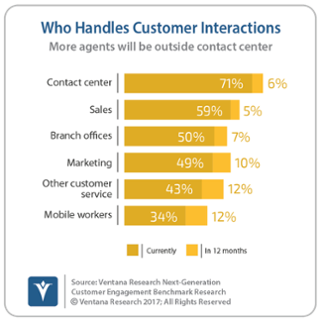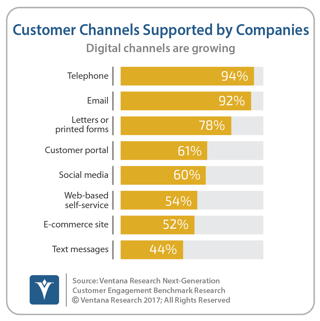A few years ago, we carried out benchmark research into customer service best practices. A key element of the research was to compare the approaches of the nearly three-fifths (58%) of organizations that described themselves as very customer-focused and the remaining two-fifths (42%) that are not so focused on their customers.
Our analysis uncovered differences in two related areas: the use of customer personas (detailed customer profiles) and of customer journey maps (visualization of how and why customers interact with different business groups during the customer life cycle). In the case of the use of personas, the research found that 58 percent of very customer-focused organizations use personas compared to 44 percent of less customer-focused organizations. There was a similar pattern in the use of customer journey maps with 42 percent of very customer-focused organizations using them compared to 33 percent of less customer-focused organizations.
Our benchmark research into next-generation customer engagement offers two compelling reasons why journey maps in particular are important to companies that are very customer- focused. First, the findings of the research make it quite clear that customer engagement is an enterprise issue, with nearly all business groups (with the notable exception of IT) handling customer interactions. It thus appears that very customer-focused organizations have realized that to optimize the customer experience they need to know who handles interactions. And they need to know the specifics of the journeys customers take as they transition from searching for a product/service, to buying, to looking for support, to being billed as well as what actions they take because of their experiences.
focused. First, the findings of the research make it quite clear that customer engagement is an enterprise issue, with nearly all business groups (with the notable exception of IT) handling customer interactions. It thus appears that very customer-focused organizations have realized that to optimize the customer experience they need to know who handles interactions. And they need to know the specifics of the journeys customers take as they transition from searching for a product/service, to buying, to looking for support, to being billed as well as what actions they take because of their experiences.
Second, customer engagement now takes place across multiple channels of engagement, from phone calls to email messages, letters, the corporate website, social media, text messages, online chat sessions and video. Organizations thus need to know which channels customer use to do what, whether customers need to use multiple channels to resolve the same issue and which channels are most successful. During briefings with vendors using journey maps, I find most focus on visualizing what communication channels are used, and what percentage of calls lead ultimately to the caller sending an email or text message or tweet – in other words, the communication channel journey. I believe complete journey maps should depict all the information relating to customer journeys – which business groups interact with which customers, on what channels, to do what and, most importantly, outcomes and actions.
place across multiple channels of engagement, from phone calls to email messages, letters, the corporate website, social media, text messages, online chat sessions and video. Organizations thus need to know which channels customer use to do what, whether customers need to use multiple channels to resolve the same issue and which channels are most successful. During briefings with vendors using journey maps, I find most focus on visualizing what communication channels are used, and what percentage of calls lead ultimately to the caller sending an email or text message or tweet – in other words, the communication channel journey. I believe complete journey maps should depict all the information relating to customer journeys – which business groups interact with which customers, on what channels, to do what and, most importantly, outcomes and actions.
Producing these kinds of maps to enable organizations to fully optimize customer engagement is not easy. It requires systems that can access all sources of customer data, both transactional data such as orders, invoices and support cases and data on interactions such as phone calls, email messages and chats. It is also key that the systems be able to create maps that are useful for different users – among them, employees in marketing, salespeople and contact center managers. I also believe it is vital that they show the outcomes of interactions – whether journeys led to the desired customer and business outcomes. Knowing outcomes allows organizations to optimize journeys from both the customer’s and the organization’s perspective: Can journeys be shortened? Can the information provided at a point of interaction be changed so customers don’t have to try another channel or repeat what they have done? What interactions could be automated using bots? The improvement opportunities are endless.
In the past, what I describe as old-school journey maps were often created by cross-departmental groups getting together and mapping desired customer journeys using sticky posted notes that showed how the organization would like and expect customers to interact with them. Today, as with many things, these sticky notes have been replaced by digital technology that uses real data to map real journeys that customers actually take. These tools have become an essential part of an organization’s “360-degree view of the customer” – a complete analysis of all customer-related information, including marketing, sales, service, finance and interaction information. I am a firm believer that without such a view it is impossible for organizations to understand the experiences of different customer segments (personas) and then decide what actions they should takes as the result of interactions, and how to optimize journeys from a customer and business perspective. Several vendors now provide systems that produce customer journey maps so I recommend that organizations looking to improve the customer experience evaluate which can help them with those efforts.
Regards,
Richard Snow
VP & Research Director, Customer Engagement
Follow Me on Twitter and Connect with me on LinkedIn











